Study Overview
- Aiken, L., Sloane, D., Ball, J., Bruhneel, L., Rafferty, A., & Griffiths, P. (2018). Patient satisfaction with hospital care and nurses in England: An observational study. BMJ Open, 8, 1-8.
- Exploration of patient satisfaction with nurses and hospital care;
- An observational study in the context of English healthcare facilities;
- Aims to inform healthcare decision-makers regarding policy changes by depicting how the perceptions of patients regarding care are linked confidence in doctors and nurses;
- Study chosen for its look on patients’ perceptions and factors that contribute to the increased satisfaction with care;
- Low care quality is a significant barrier to reaching optimum health outcomes and building trust between patients and nurses.
- The research is important to the exploration of patient satisfaction as related to care outcomes;
- The scholars encouraged looking at the problem of poor nursing care through the patient perspective;
- Missed nursing care should not be blamed on nurses but rather addressed with the help of developing positive hospital environments, adequate nurse-to-patient ratios, and the increased quality of practitioners’ education;
- The overall intention of the article was to identify an action plan that may be beneficial for improving patient experiences at hospitals;
- The research is the first quantitative study to reveal associations between patient experiences and their trust in care providers.
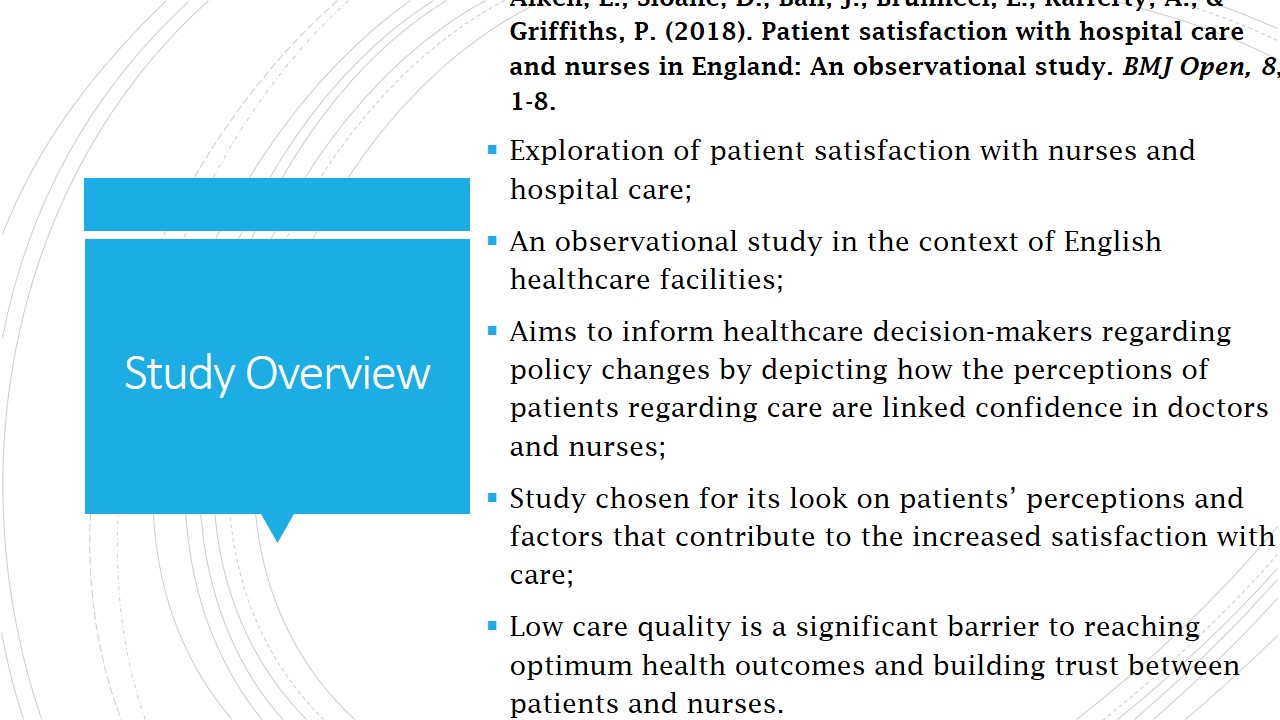
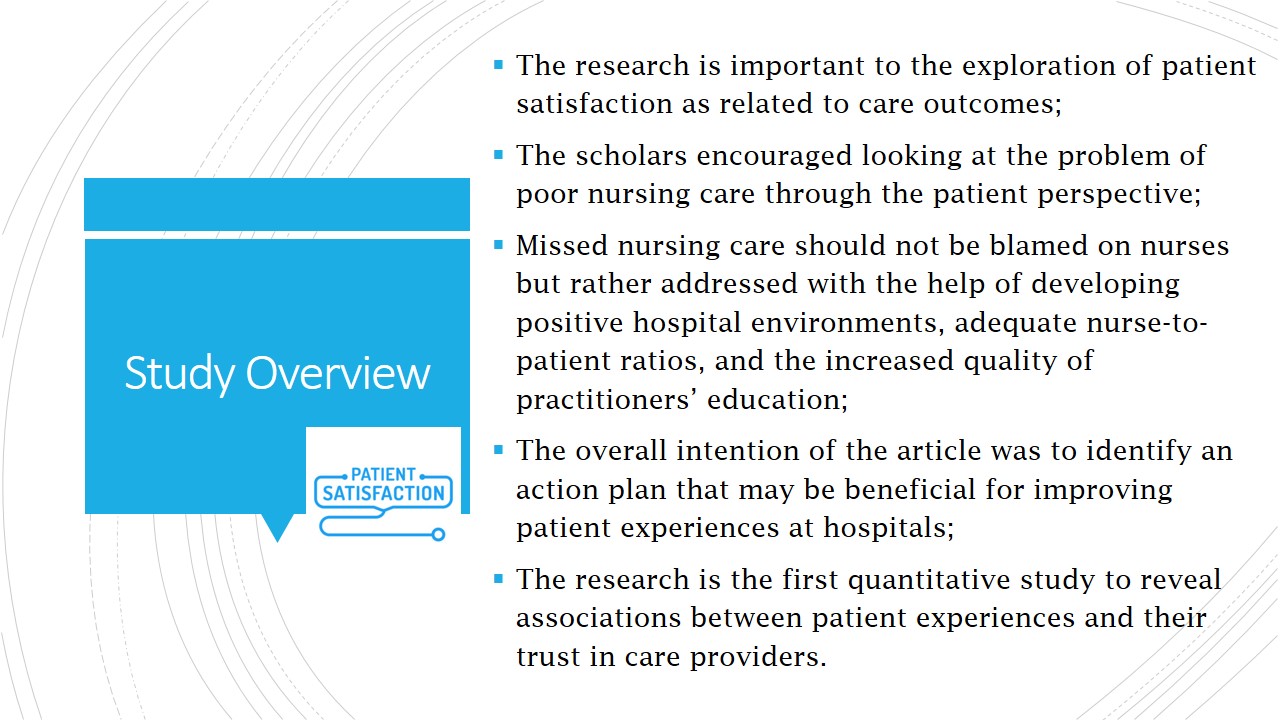
Research Study Elements
- All essential components of a research study are present;
- The breakdown of a study into sections is necessary for the purpose of better presentation as well as the logical layout of material (Patten, 2017);
- The article includes:
- Abstract;
- Introduction;
- Methodology (data sources and samples, analysis strategy);
- Results (“nurses, doctors and patient care ratings, nurse staffing, hospital environments, and missed care, missed nursing care and patient outcomes”) (Aiken et al., 2018, p. 1);
- Discussion, conclusion, limitations, acknowledgments and references.
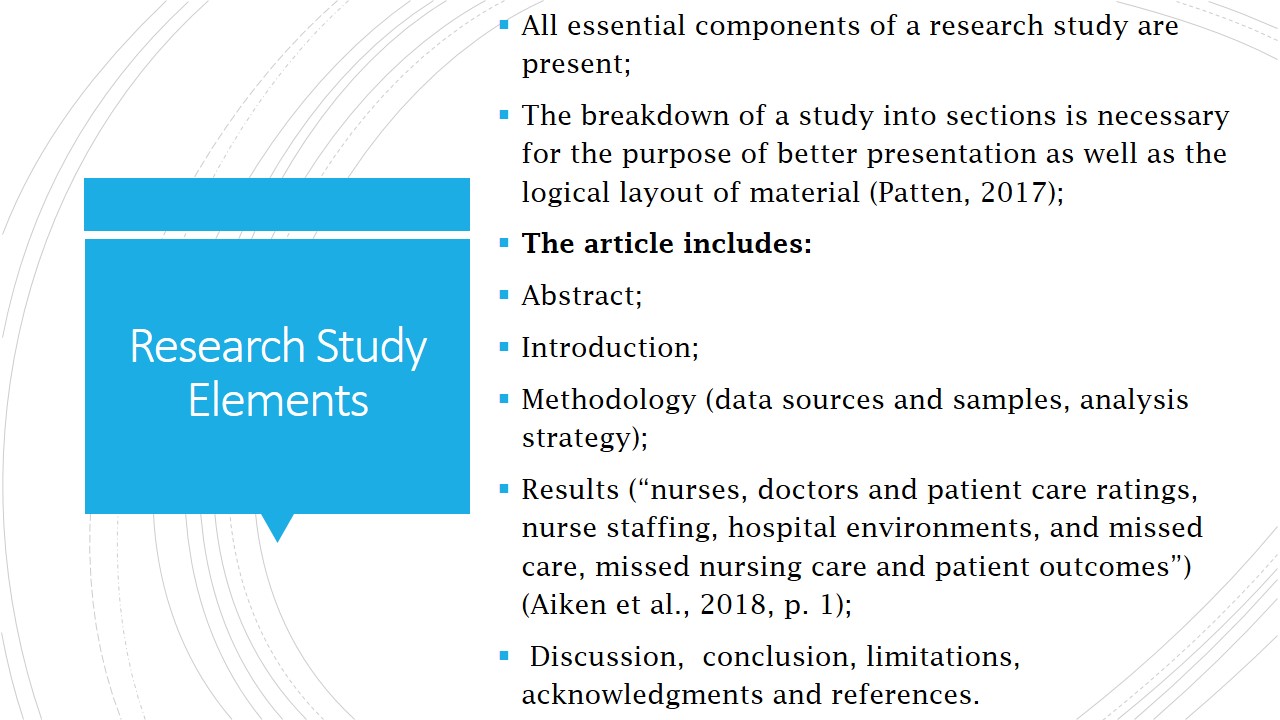
Effectiveness
- The authors are effective in communicating the problem explored in the study;
- In the introduction, they discuss the problem of inadequate nursing care negatively contributing to patient outcomes;
- Aiken et al. (2018) also discuss connections between staffing and hospital environments in regards to lowering patient satisfaction and confidence in their care providers;
- The authors also underline the importance of introducing workplace initiatives to train both nurses and doctors to cater to consider patient satisfaction as an essential step in care provision;
- The issue of missed care is also discussed by the authors as a contributor to low satisfaction and poor patient outcomes;
- Missed care is attributed to high patient-to-nurse workloads as well is associated with the increased likelihood of mortality.
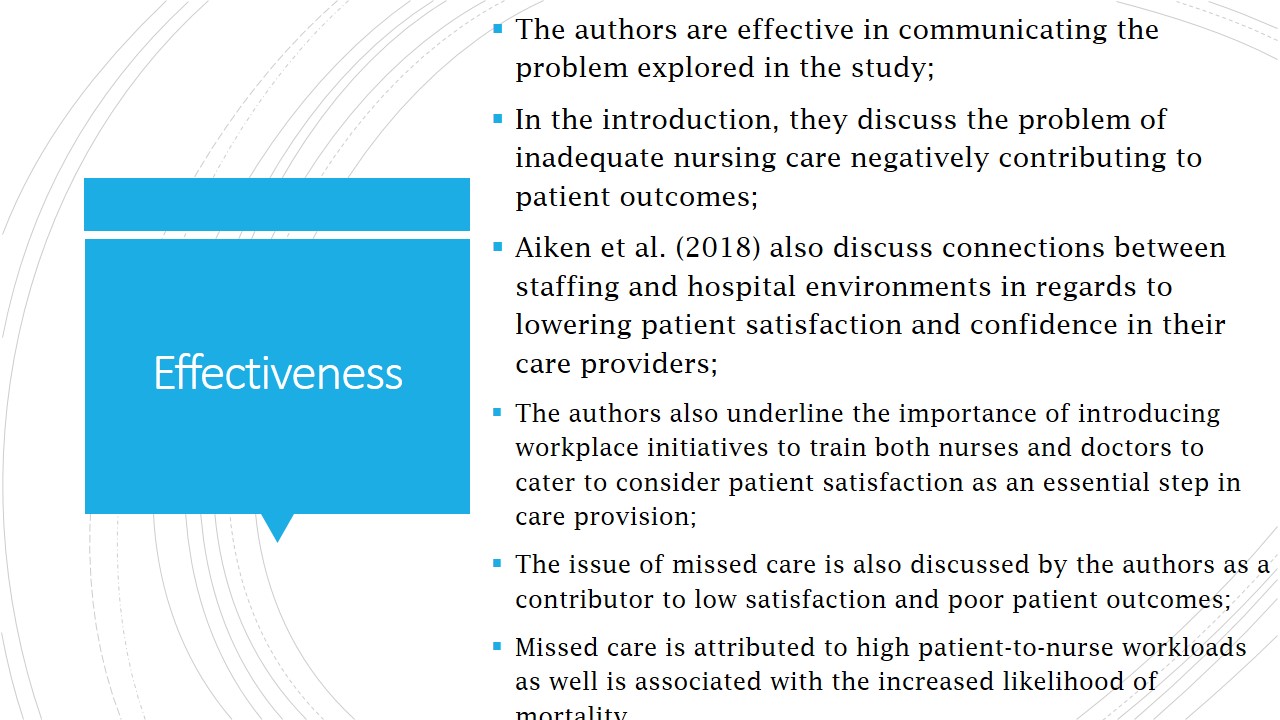
Hypothesis
- The authors do not include the hypothesis in the article;
- From the beginning of the article, it is made clear that the authors support the idea that there is an association between patient satisfaction (perceptions of hospital care) and confidence in nurses and doctors, work environments, and nursing staffing levels;
- The aim of the study was to inform healthcare policymakers of the need to adjust their approach to care improvement in order to benefit patients from multiple perspectives;
- The authors also mentioned the key outcome measures in the study that relate to the enhancement of care quality and the increase in confidence of doctors and nurses.
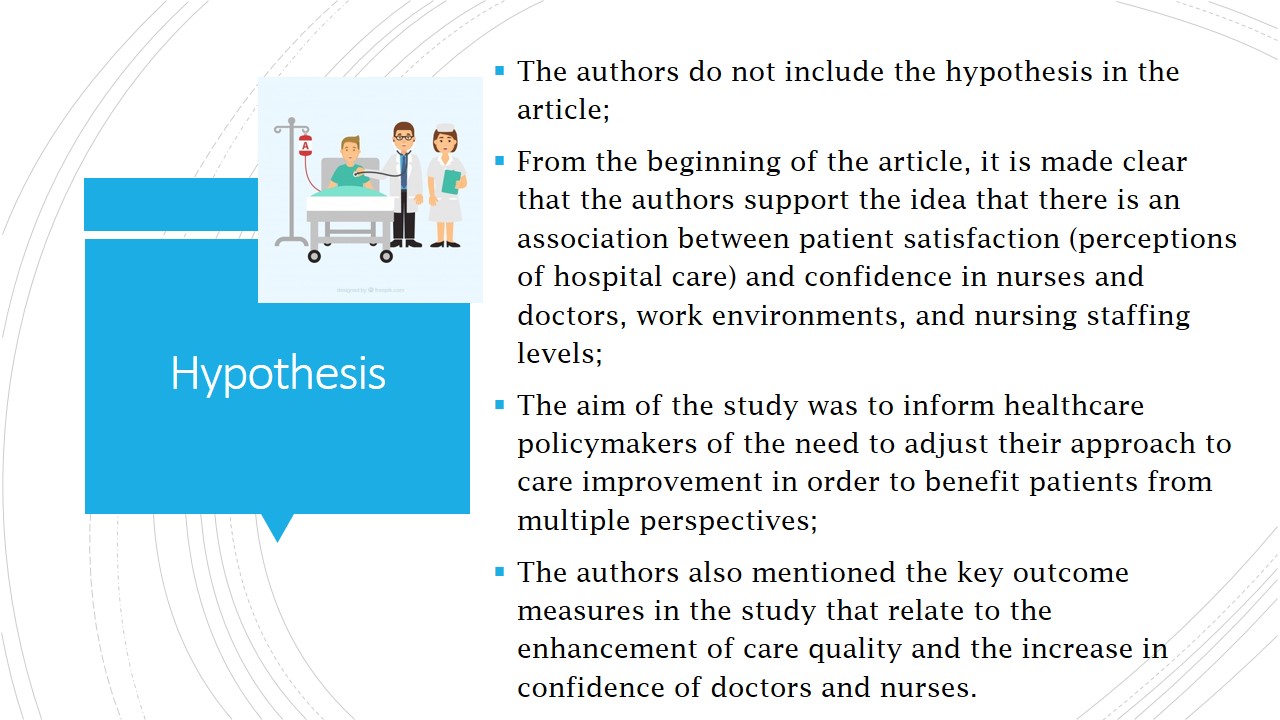
Literature Review Summary
- The literature review supported the need for Aiken et al.’s (2018) study:
- The inadequate quality of care delivery leads to significant health deficiencies and preventable deaths among patients;
- Large gaps in nurse-to-patient ratios across NHS hospitals lead to higher mortality rates;
- However, nurses and other staff at hospitals should not be blamed for deficits in care as it is the inadequate management that leads to challenges;
- Bachelors-prepared healthcare providers show a better quality of care and increased patient outcomes;
- Concerns regarding nurses and doctors lacking compassion or uncaring of patients have been attributed to anecdotal evidence rather than research.
- Various studies have pointed to the use of mandatory hospital satisfaction surveys to reveal whether the quality of care provided at hospitals;
- Missed patient care is linked will lower rates of patient satisfaction;
- An action agenda is needed to establish a high expectation of care delivery and building trust between practitioners and patients;
- Large sample populations should be used in current and future research to ensure representativeness as well as the variability in patient feedback regarding care quality;
- The literature review concludes with the statement that “lower nursing workloads and better work environments are related to less missed care while, in turn, less missed nursing care is related to better patients’ experiences with their care” (Aiken et al., 2018, p. 1).
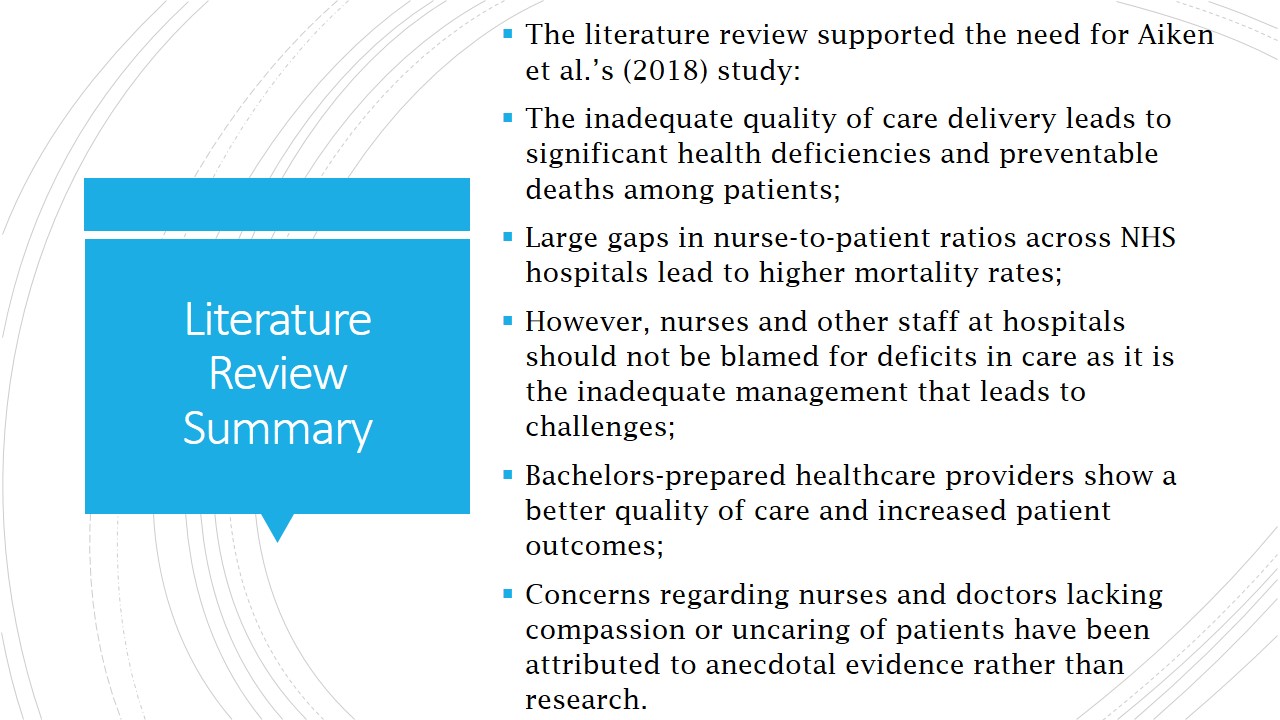
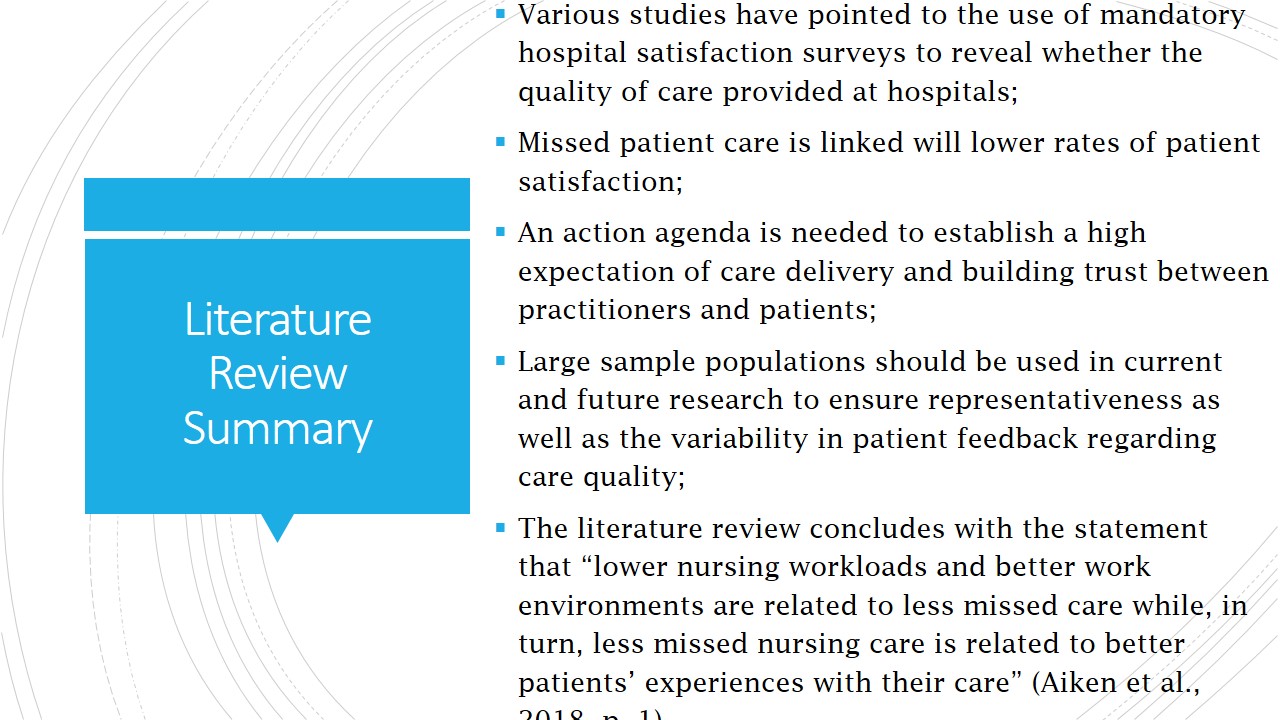
Research Design
- The study used a cross-sectional survey from the 2010 NHS Survey of Inpatients;
- Data acquired from surveys was quantitative in nature.;
- Participants were asked to describe what they thought of the questionnaire as well as to give feedback on the aspects of care that are the most important to them;
- The chosen research design was implemented because of the possibility to reach a wide patient population;
- Cross-sectional study represents an observational research methodology that aims to collect and analyze data from a representative group of people at specific time (Patten, 2017);
- Thus, the research design is consistent with the class content related to the exploration of various approaches to methodology.
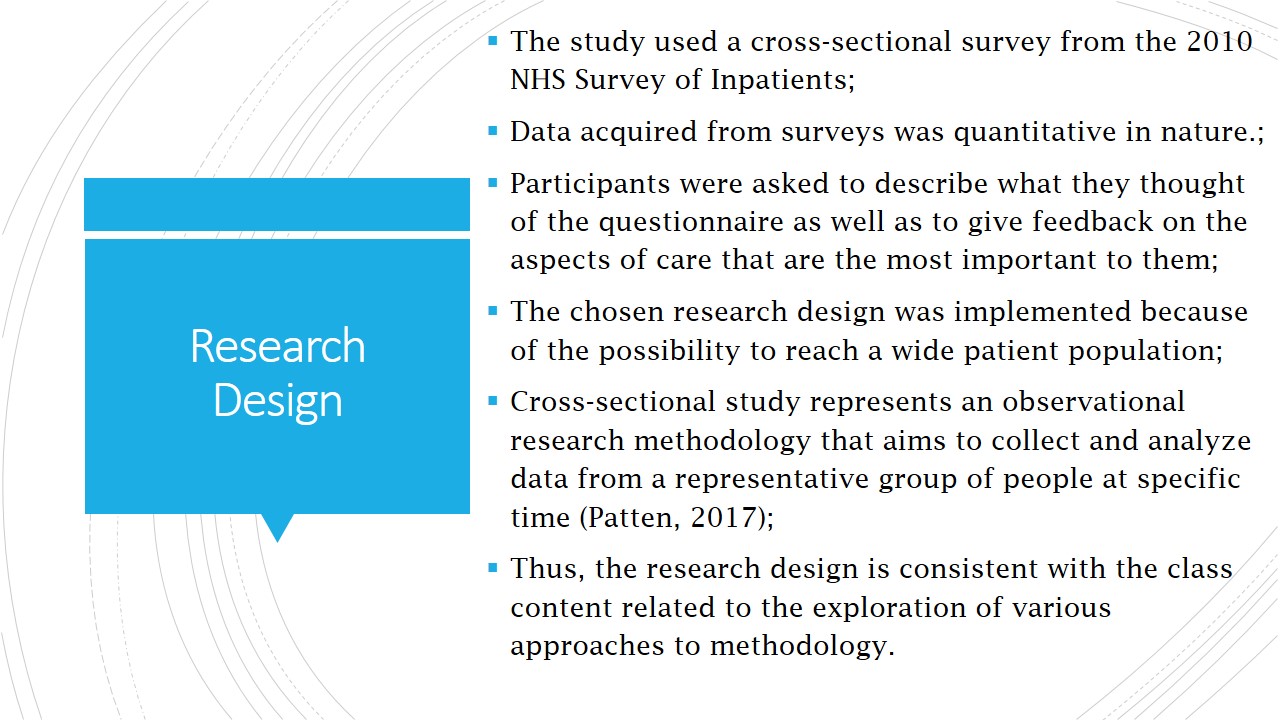
Variables
- The variables included in the study refer to patients’ perceptions of care, individuals’ confidence in doctors and nurses, health outcomes, and nurses’ attitudes;
- There is a lack of substantial discussion of the variables;
- No confounding variables have been adequately identified in the article;
- Aiken et al. (2018) mentioned that ”from models that tool account of numerous confounds, we estimated that the likelihood of patients saying there were always enough nurses to care for them were about 40% lower in hospitals” with 1 to 6 nurse-to-patient ratios;
- It is recommended to further the discussion on variables as it is unclear which confounds were considered as well as why the specific variables were chosen.
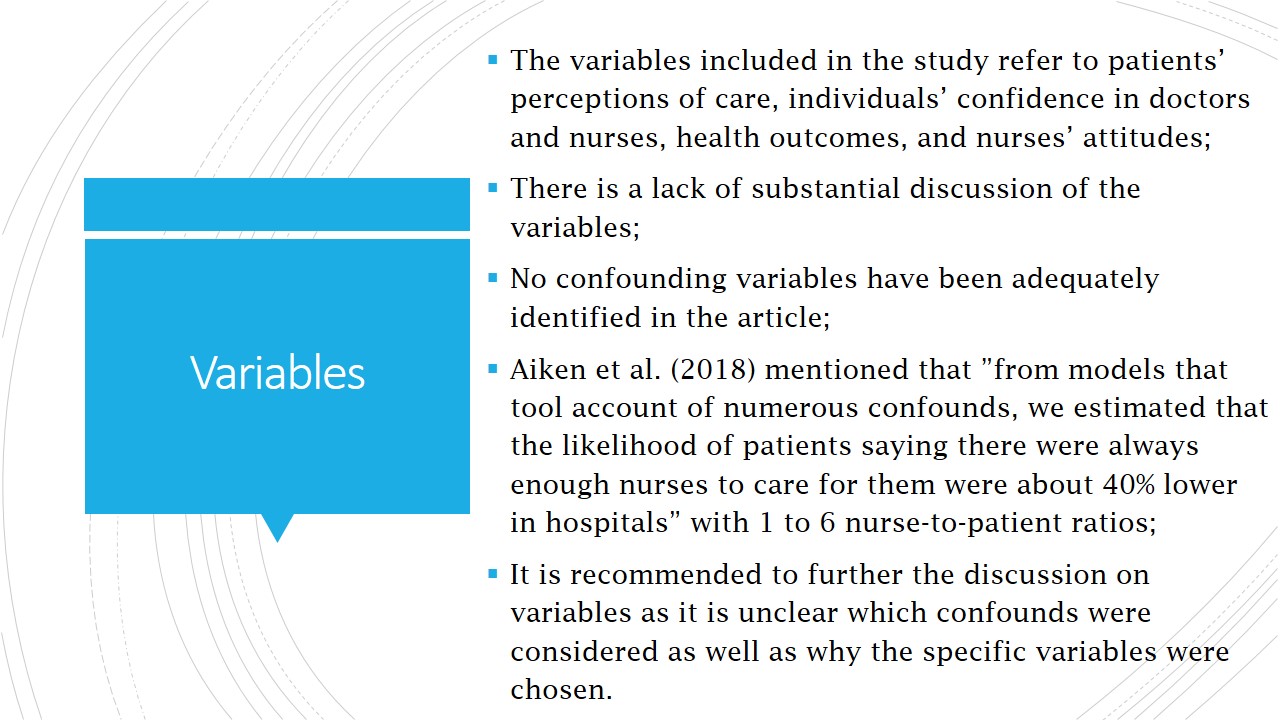
Sampling
- The hospitals in which nurses were questioned is a stratified random sample that was used to include hospitals with both teaching and non-teaching programs in multiple locations;
- Data was collected from 2963 impatient medical and surgical direct-care registered nurses;
- Survey data was taken from the 2010 NHS Survey of Inpatients that included over 66000 patients that were discharged from hospitals;
- No inclusion and exclusion criteria for the sample population are mentioned;
- The authors are unclear about the sampling procedures implemented during the research, which is a significant limitation.
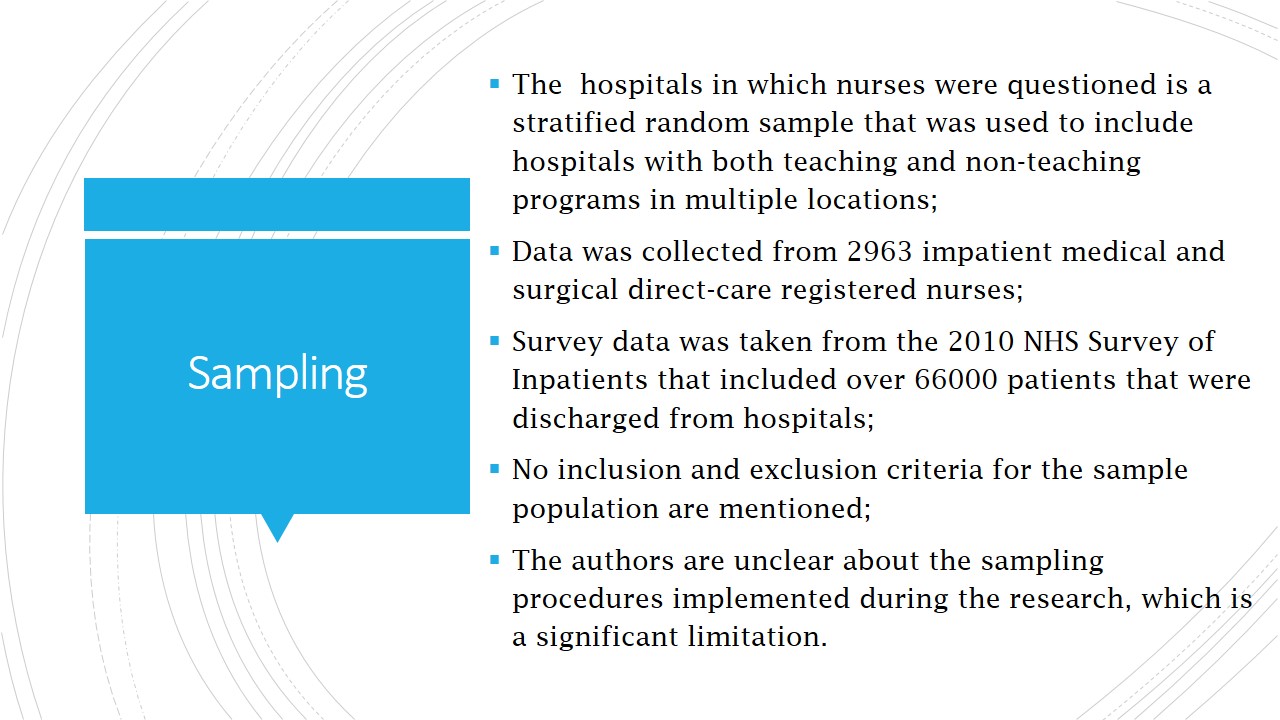
Limitations
- The main limitation of the study is attributed to the use of cross-sectional data;
- Despite the fact that authors provide consistent explanations of their models, a possibility cannot be ruled out that omitting some variables could lead to associations found (Aiken et al., 2018);
- Generally, cross-sectional studies are limited because both exposure and outcome are assessed at the same time, and there is no evidence suggesting a temporal connection between the two variables;
- Therefore, when longitudinal data is not available to researchers, it becomes more complex to establish cause and effect relationships between variables.
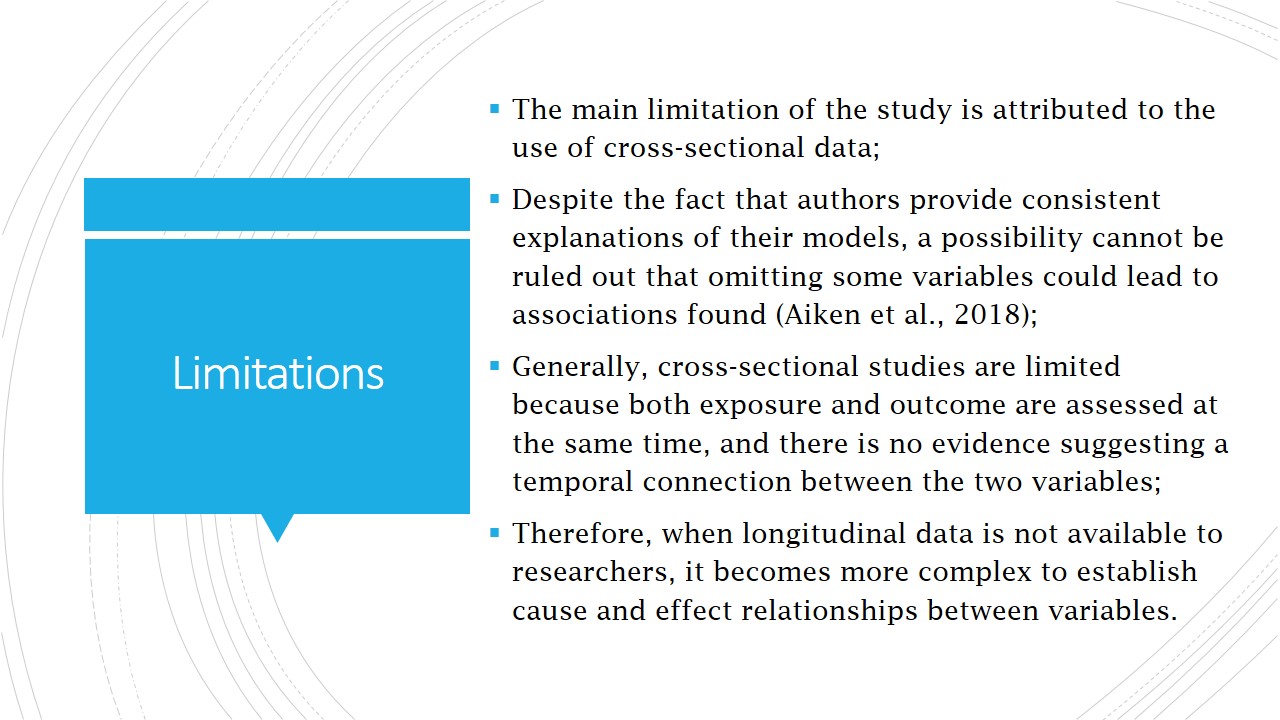
Data Collection
- Data was collected from NHS surveys completed by patients who were released from either specialist or acute hospital settings;
- The response rate for the NHS survey “was 50% while the response rate for nurse survey was 37%” (Aiken et al., 2018, p. 3);
- In the initial design, patients were not active participants;
- During pilot testing, patients were asked to complete questionnaires that inquired about their experiences with health care;
- The authors did not provide a cohesive discussion of data collection methods as patient information was already available from previous research.
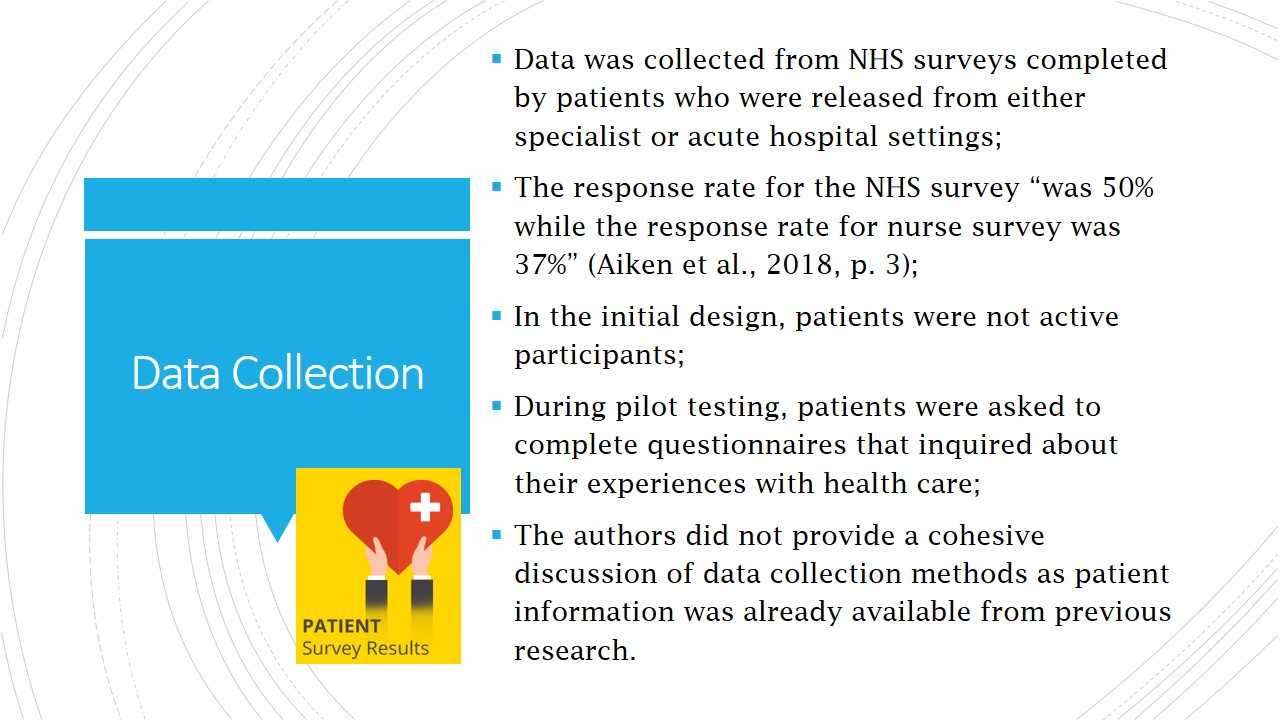
Ethical Considerations
- The authors of the article mentioned that all study participants were anonymous;
- Anonymity is an essential step for ensuring the preservation of personal information;
- The study was approved from the perspective of ethics by the University of Pennsylvania Institutional Review Committee (IRB);
- There is, however, a lack of discussion as to how ethical considerations were incorporated into the study;
- The scholars should have taken into account not only anonymity but also informed consent, accountability, and research procedures as related to participants.
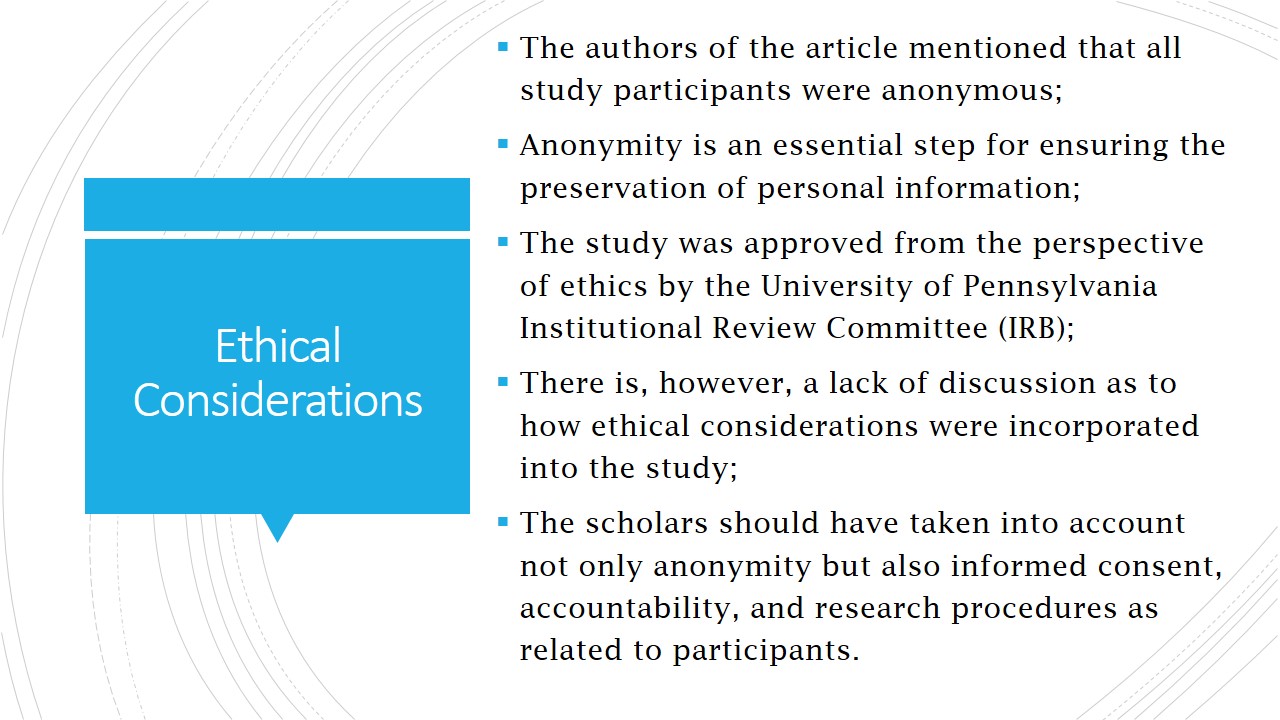
Data Analysis
- Data collected for the study was used during three separate but related analysis procedures;
- Patient data taken from 161 trusts was used for describing how patients rated their care;
- Nurse data from 46 hospitals and 31 trusts was used for explaining variations in registered nurse staffing and hospital environments;
- As data on patient surveys was only available from 31 trusts, logistic regression was used to estimate the overall levels of dissatisfaction with missed care;
- There is a lack of in-depth discussion as to how data was analysed specifically, which is a significant limitation.
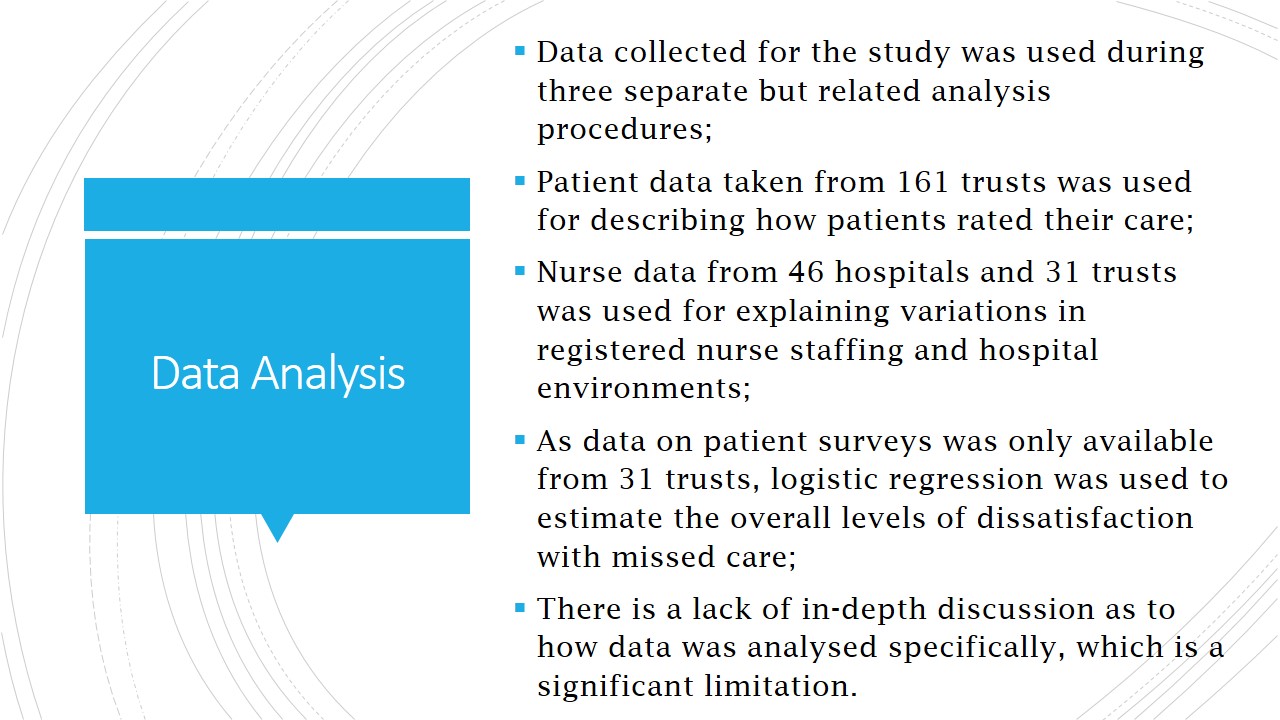
Conclusions
- The authors came to the conclusion that patients, in genera,l show a high level of confidence in the care provided by doctors and nurses;
- The satisfaction with hospital care is usually on a lower level when there is a perceived gap in nurse staffing rates;
- There is no evidence to support the narrative that the deficits in quality care are attributed to ‘uncaring’ or ‘disinterested’ healthcare providers;
- It was concluded that the reduction in missed nursing care could be achieved by offering adequate numbers of nurses at hospitals and improving clinical care environments;
- The proposed solutions to poor care quality and patient dissatisfaction;
- Policymakers should develop strategies for enhancing patient satisfaction by connecting education, adequate staffing, and positive hospital environments.
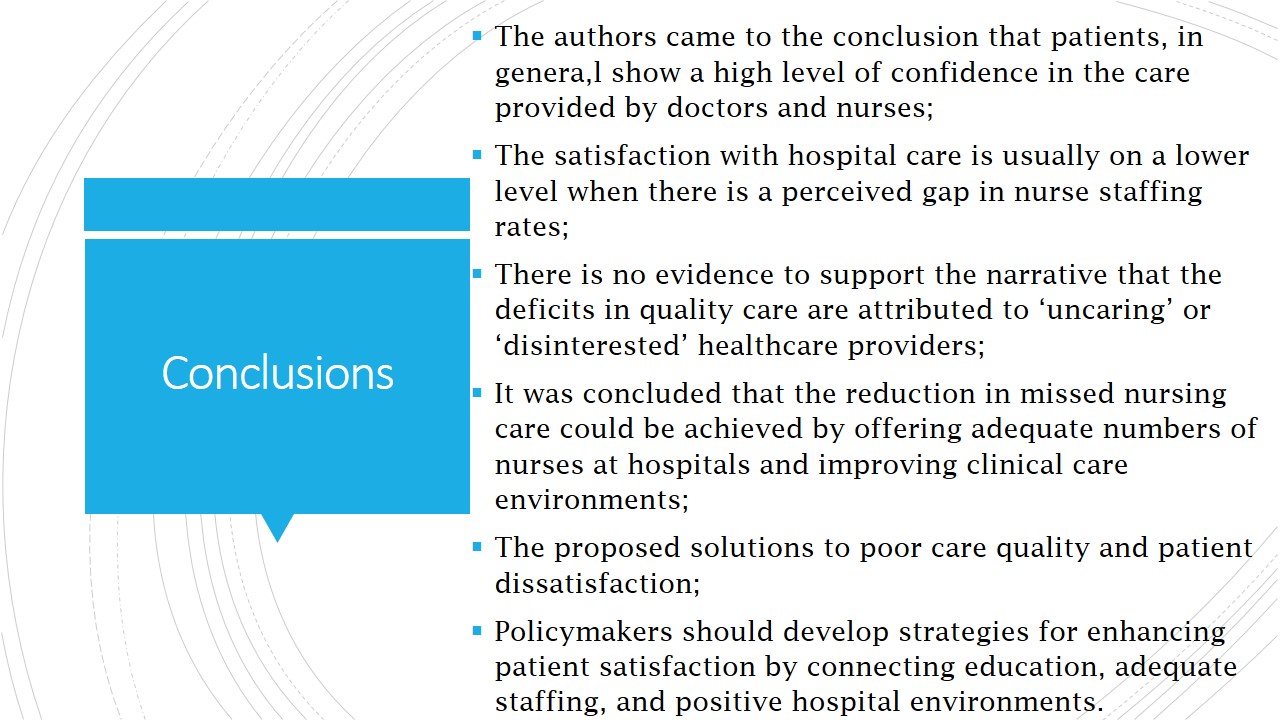
Evaluation: Strengths and Limitations
- The research is greatly valuable for underlining the importance of considering patient satisfaction when providing care to patients;
- The confidence of patients in their doctors or nurses is essential for developing positive relationships as well as improving care outcomes;
- However, in some instances, the authors were not clear about their data collection and analysis procedures, proceeding swiftly to the results;
- Implications for future practice are not discussed in detail;
- Moreover, the research did not include real patients-participants, relying instead on data collected previously in the NHS survey.
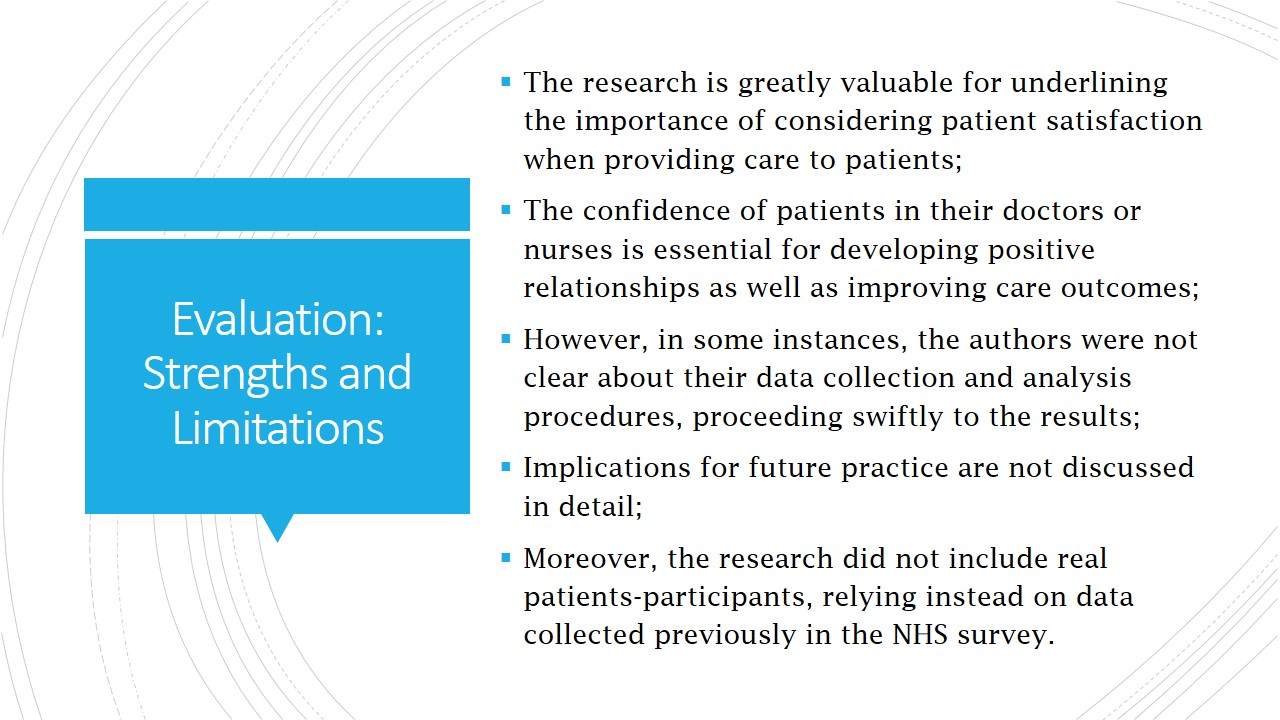
Open-Ended Questions
- What is the best way to ensure that patient satisfaction is maintained on the highest level?
- What hospitals are doing wrong when patients show low satisfaction and high mistrust in their nurses and doctors?
- How can Aiken et al.’s (2018) study be improved in order to reveal more detail into patients’ perception of nursing care?
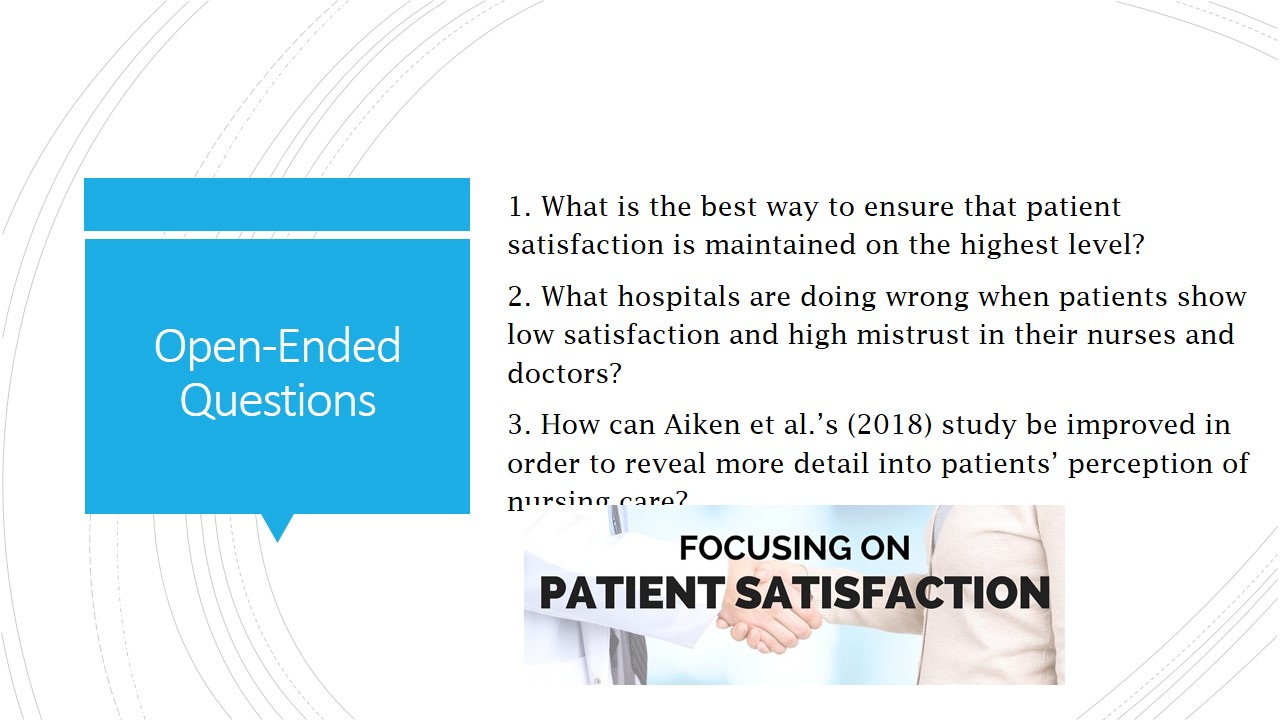
References
Aiken, L., Sloane, D., Ball, J., Bruhneel, L., Rafferty, A., & Griffiths, P. (2018). Patient satisfaction with hospital care and nurses in England: An observational study. BMJ Open, 8, 1-8.
Patten, M., & Newhart, M. (2017). Understanding research methods (10th ed.). Abington, UK: Routledge.